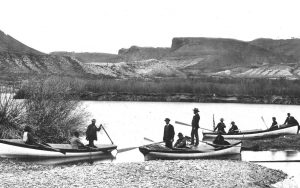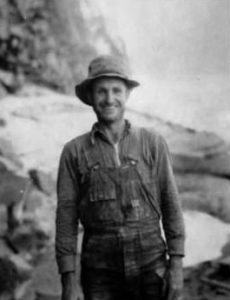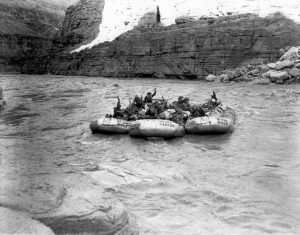John Wesley Powell’s 150th Anniversary
Explorer John Wesley Powell’s 150th Anniversary
When one thinks of Lake Powell, what images come to mind? Smooth sandstone in myriad shades of red and beige? Maybe a houseboat floating on still water, or a jet ski with a water skier in tow? But, do you realize what’s underneath all that water? Or, do you know who the lake was named for? The damn that formed Lake Powell was completed in 1963, and with that Glen Canyon began to recede beneath the mounting water of the Colorado river. However, almost a hundred years before that last bit of concrete was poured into the damn, John Wesley Powell floated through the now drowned canyon as part of a historical expedition.
In 1869 Powell set out from Green River Wyoming on what would be a 3 month journey through the canyons of Flaming Gorge, Lodore, Desolation, Cataract and of course the Grand Canyon. It was the first cartographic and geologic survey of these largely unexplored (to white settlers at least) areas of the desert Southwest. Powell’s party was ill-equipped for the water they encountered. They lost their first boat in Lodore canyon in a rapid that thereafter was named Disaster Falls. One of the party, Frank Goodman, left the expedition on July 6th. He eventually settled in Vernal, Utah, and their raised a family. Three more of Powell’s men left on August 30th, two days before the expedition’s end. Unfortunately these three were never heard from again. Of the ten men and four boats that began the journey, six men and three boats finished it.
Powell wasn’t just an intrepid explorer. He served in the Civil war, where he would eventually gain the rank of major and lose most of his right arm. He was also an accomplished geologist and a professor at Illinois Wesleyan University. On his expedition he was awestruck by the features he saw. How could a river cut straight through a mountain? he wondered. It went against everything we knew about geology at the time. But Powell’s interests weren’t purely geologic, but anthropologic as well. The evidence of the human history, the pottery shards, granaries, and habitations of the Native Americans did not escape his notice. So enamored was Powell by what he saw on that first expedition that in the winter of 1871 he retraced part of that expedition from Green River Wyoming to Kanab creek in the Grand Canyon. Powell saw in the rock the age of our world, how old it was, and how truly dynamic it was. He also saw, with a surprising amount of prescience for his time, that Westward expansion would be limited by access to water.
After his expeditions, Powell went on to educate the public about the things he had seen. In the time of Manifest Destiny, he had a surprising amount of prescience to see that Westward expansion would be limited by access to water. Unfortunately, his ideas and proposed policies on irrigation of the West were ignored due to corporate interests. Famously, Powell stated “you are piling up a heritage of conflict and litigation over water rights, for there is not sufficient water to supply the land.” These words would become manifest forty years later during the Dust Bowl. He would also eventually go on to become the director of the Bureau of Ethnology, a position he held until his death in 1902.
This year marks the 150th anniversary of Powell’s expedition. While Flaming Gorge and Glen Canyon are now underwater, one can still experience many of the canyons of that 1869 expedition in the same way Powell did. Beginning on May 24th the John Wesley Powell River Festival will launch. Towns all along his route will be holding events and festivities to celebrate the man and the impact of his expedition.
Call us today 1-800-345-7238 for details about our 4 day Green River Gates of Lodore trip focused on celebrating the 150th anniversary of John Wesley Powell’s incredible journey along the course of the Green River and Colorado River.


